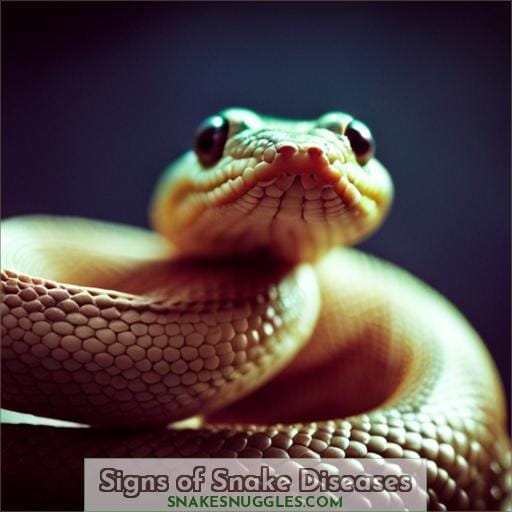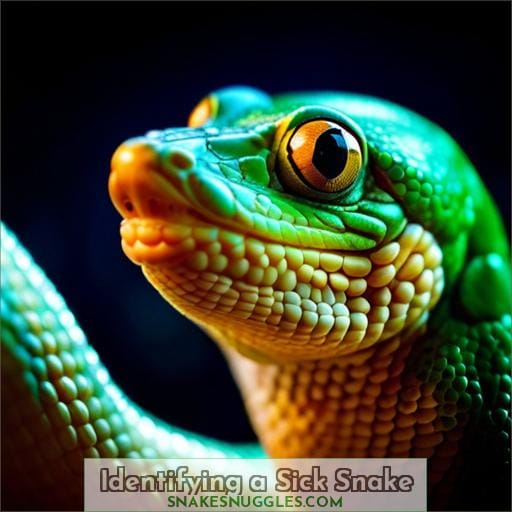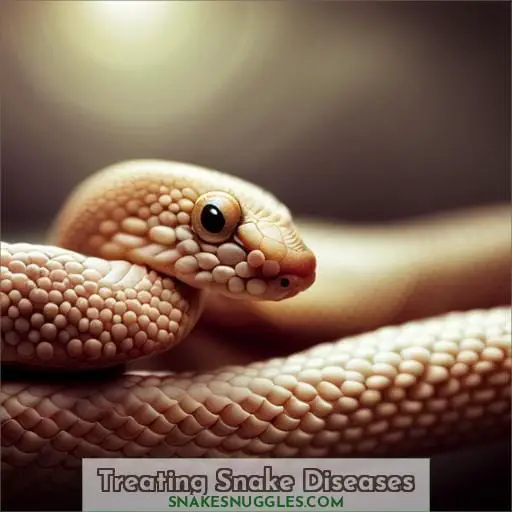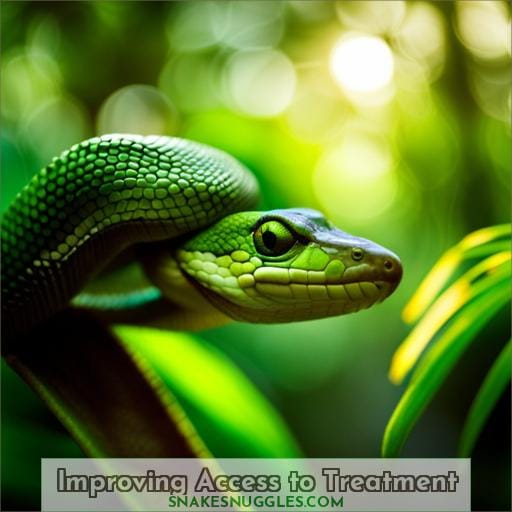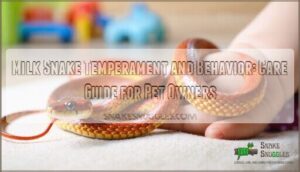This site is supported by our readers. We may earn a commission, at no cost to you, if you purchase through links.
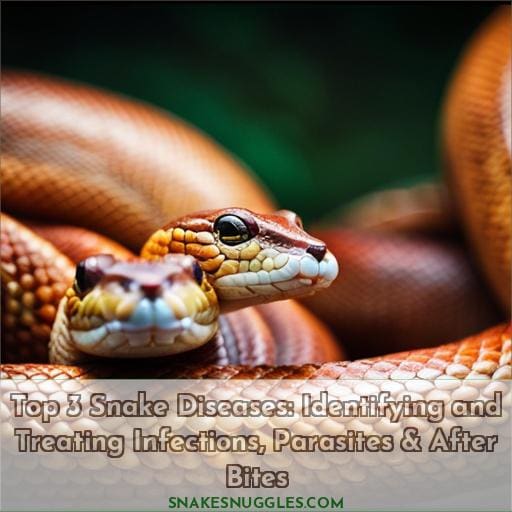 Symptoms of common snake diseases include:
Symptoms of common snake diseases include:
- Coughing
- Wheezing
- Nasal discharge
- Skin lesions
- Diarrhea
You can’t afford to ignore these. If you care about the well-being of your pet, you’ll want to continue reading to learn more about the top three most common snake diseases, their symptoms, and treatments.
Table Of Contents
- Key Takeaways
- Signs of Snake Diseases
- Identifying a Sick Snake
- Treating Snake Diseases
- After a Snake Bite
- Challenges for Antivenom Production
- Improving Access to Treatment
- Frequently Asked Questions (FAQs)
- How can I prevent my snake from getting sick?
- What are the long-term effects of snake diseases if left untreated?
- How can I tell if my snake is stressed or anxious?
- What are some common myths or misconceptions about snake diseases?
- Are there any natural remedies or homeopathic treatments for snake diseases?
- Conclusion
Key Takeaways
- Mouth infections: Characterized by cheesy discharge, require injectable antibiotics and regular cleaning.
- Parasites: Cause diarrhea or constipation, treated with deworming and enclosure deep cleaning.
- Skin infections: Result from wounds or bacterial infections, require topical ointments and antibiotics.
- Respiratory disease: Caused by irritants, parasites, or infections, requires nebulization and humidity control.
Signs of Snake Diseases
Look for signs of infectious stomatitis:
- Hemorrhages on the gums
- Thick mucus with blood or pus in the mouth
- Swelling around the mouth
- Open-mouth breathing
- Loss of appetite when trying to identify common snake diseases.
Skin infections may cause inflamed, blistering skin.
Breathing issues:
- Wheezing
- Open-mouth breathing
Could indicate respiratory disease.
Lethargy, lack of appetite, and open-mouth breathing are non-specific signs of illness to watch for.
Regularly inspect your snake’s body for any parasites like mites and ticks, which are visible to the naked eye.
Getting a snake checked by a vet at the first sign of abnormal behavior is crucial for effective treatment and recovery.
Identifying a Sick Snake
- Here are 3 tips for identifying a sick snake:
- Start by examining its mouth for any cheesy discharge, which could indicate infectious stomatitis.
- Carefully inspect its scales, especially around the head, for any mites or ticks buried beneath them.
- Check for any abnormalities in its droppings like diarrhea or constipation.
- Also monitor your snake’s behavior for signs of lethargy or lack of appetite, which can indicate illness.
- Observe its environment too – look for accumulated mucus or skin stuck on cage furnishings.
- With attentive observation and quick action, you can catch health issues early and get your snake the veterinary care it needs.
Treating Snake Diseases
- You’ll need to treat mouth infections with injectable antibiotics, deworm snakes for parasites, including managing common external parasites like mites and ticks using snake parasite treatment, prescribe topical treatments for skin issues, and use nebulization for respiratory problems.
- Most conditions require a deep clean of the snake’s environment alongside medication to prevent reinfection.
- Aggressive treatment, antibiotics, fluids, and assisted feeding may be necessary for severe illnesses like septicemia.
Mouth Infections
You’ve gotta fight mouth infections aggressively with:
- Injectable antibiotics
- Removal of buildup
- Rinsing the mouth with antibiotic solutions
- Perform an oral examination to check for underlying conditions.
- Send a culture for testing to identify the pathogen.
- Correct husbandry issues to prevent reinfection.
Parasites
Using parasites to treat snake diseases involves carefully diagnosing and managing common internal parasites like roundworms, hookworms, and tapeworms in pet snakes.
A deworming schedule helps eliminate intestinal parasites.
Deep clean the enclosure to remove parasite eggs.
Monitor appetite and stool.
Weigh regularly.
If untreated, parasites can cause anemia, septicemia, even death.
But with diligent care, parasites can be controlled.
Skin Infections
Your snake’s skin infections need prompt treatment with proper environment, hygiene, antibiotics, and topical therapy.
- Use topical ointments after cleaning wounds.
- Administer antibiotic injections for bacterial infections.
Provide humid housing and improve husbandry to boost immunity against respiratory disease or inclusion body disease.
This neglected tropical disease remains a public health concern, though viral diseases are less common than infections treatable with improved husbandry.
Respiratory Disease
- Provide appropriate humidity and temperature to support lung healing.
- Regularly nebulize with saline to hydrate airways.
- Identify and treat underlying parasites or infections with antibiotics.
- Adjust environment to remove irritants triggering breathing difficulty.
- Consult an exotic veterinarian for x-rays or respiratory cultures to pinpoint causes.
- With attentive care, snakes can recover from respiratory disease.
After a Snake Bite
After a snake bite, your immediate response is crucial to minimize long-term effects.
Remain calm and still. This helps slow the spread of venom.
Don’t attempt to cut or suck the venom out.
Call emergency services right away, even if bite symptoms seem mild at first, as they can rapidly worsen.
Keep the bitten area slightly lower than heart level to slow venom absorption into circulation.
Remove any constricting clothing or jewelry since swelling often develops rapidly.
Cover with a clean, dry dressing to minimize infection risk.
Once at a medical facility, follow all treatment recommendations closely to support full recovery.
Although scary, most bites can be effectively managed with proper first aid and medical care to prevent lasting damage.
Stay vigilant and act quickly.
Challenges for Antivenom Production
You’ve survived a snake bite, but producing the antivenom is rife with challenges.
Despite the dangers of snakebites in tropical regions, few countries can generate quality snake venoms for antivenom manufacturing.
Relying on common venom sources fails to reflect geographical diversity in snake venoms.
Furthermore, deficient regulatory capabilities obstruct evaluating antivenom quality where snakebites are prevalent.
Regulatory oversights stifle assessing antivenom quality where snake bites are most problematic.
Market failures reduce antivenom production and inflate prices, making treatment unaffordable.
Cost barriers suppress demand, decreasing availability of these lifesaving medicines.
Geographical mismatch between commercial venom sources and regional snake diversity leads to ineffective antivenoms.
Supply deficits are imminent in parts of Africa and Asia without intervention to improve policies and availability.
Improving Access to Treatment
You need better antivenom availability to improve access to snakebite treatment.
Strengthening health systems and optimizing distribution networks are key to securing the antivenom pipeline and expanding geographical access.
Community education programs raise awareness and empower people to seek proper treatment.
Financial mechanisms like subsidies can improve affordability where cost is prohibitive.
A multi-pronged approach is vital – from antivenom research and development to robust regulatory systems and data-driven distribution policies.
With coordinated efforts to make antivenoms available, affordable, and trusted, we can expand access and reduce the toll of snakebite morbidity and mortality worldwide.
Frequently Asked Questions (FAQs)
How can I prevent my snake from getting sick?
To safeguard your snake’s well-being:
- Ensure a clean habitat.
- Provide a balanced diet.
- Maintain optimal temperature and humidity levels.
Regularly inspect for signs of illness:
- Promptly seek veterinary care when necessary.
What are the long-term effects of snake diseases if left untreated?
Untreated snake diseases can lead to a life of misery for your scaly friend.
Just like a neglected garden wilts and withers without care, untreated snake diseases can cause a life of misery for your scaly friend.
How can I tell if my snake is stressed or anxious?
Observe your snake’s behavior closely for signs of stress or anxiety:
- Hissing
- Striking
- Hiding
- Refusing food
What are some common myths or misconceptions about snake diseases?
Myths abound regarding snake ailments, fostering misconceptions that hinder proper care.
Do not fall prey to baseless beliefs; seek informed guidance for your serpent’s well-being.
Are there any natural remedies or homeopathic treatments for snake diseases?
Natural remedies or homeopathic treatments for snake diseases lack scientific backing.
Consulting a veterinarian is crucial, as self-treatment can worsen the condition and compromise the snake’s well-being.
Conclusion
Like a serpent shedding its skin, you must shed your complacency.
Arm yourself with knowledge to confront the top 3 snake diseases.
Be the hero in your snake’s story, the one who vanquishes infections, parasites, and bite aftermaths.

